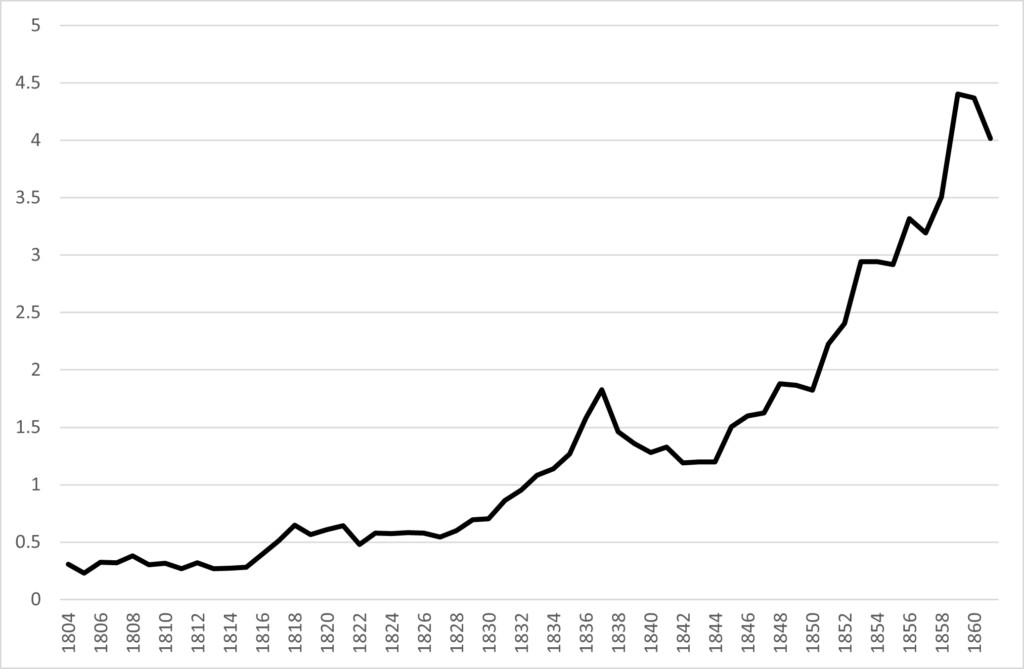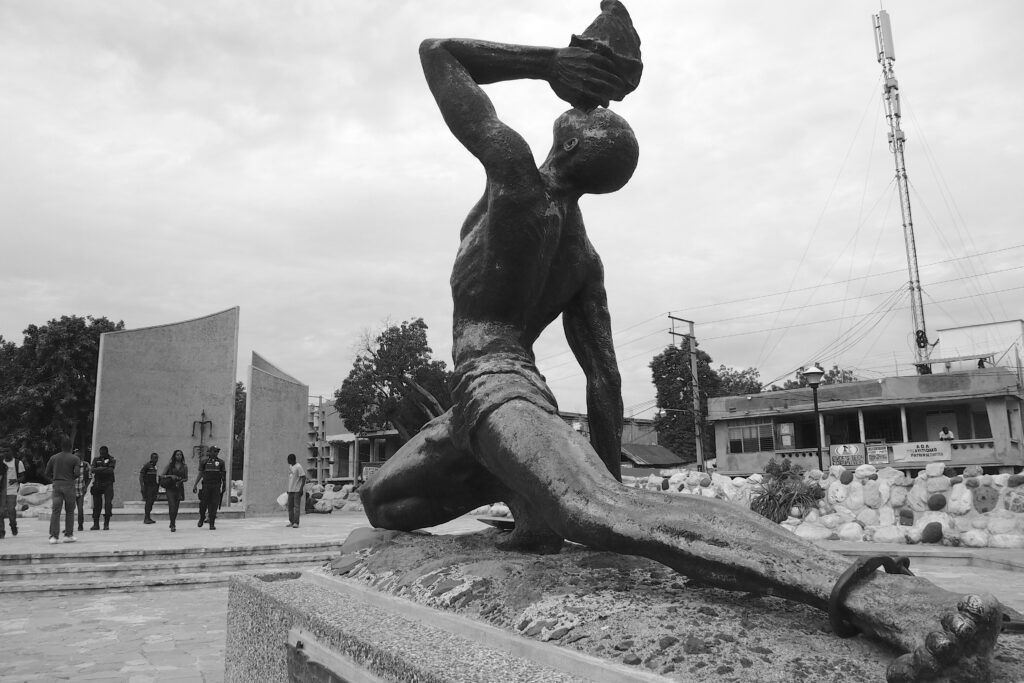It is complicated and challenging for a society to undergo radical transition. There are many vested economic interests that can experience losses from such a transition, and who therefore might be reluctant or directly opposed to change. But if we learn anything from history, then it is that transition – including very radical transition – can be possible, even when an institution is both ancient, and still highly profitable for certain interests.
This blog was originally posted in Swedish on the New Weather Sweden website.
One of the most radical transitions in global history was arguably when slavery was abolished globally during the nineteenth and twentieth centuries. Slavery was by then an institution, and had been in place for thousands of years throughout the world. Enslaved people can be found in some of the earliest documentary sources, such as ancient clay tablets from the Middle East or ancient sources from Asia. To hire labourers who voluntarily agreed to a contract – in the way most of us today take for granted how a labour market works – have been somewhat of an exception throughout most of recorded human history. For ancient landed elites, there was never any doubt that slavery was a system favourable to them. They furthermore had no moral qualms over slavery in principle. The only discussion was over exactly who could be enslaved. The philosopher Aristotle, for example, argued that only” barbarians” could be legitimately enslaved, whereas no Athenian citizen could be. Similar principles, that only ”the Others” could be enslaved, can be found in many other societies the world over. This became extremely obvious in the proto-capitalist slave societies that developed in the Americas from the sixteenth century onwards. Here, only people of African descent could be legally enslaved.
The system of slavery was as a rule extremely brutal and exploitative. The human suffering induced on the enslaved persons was enormous. But, starting in early nineteenth century, nation after nation abolished the institution of slavery. It was a process that took time. Only by the twentieth century had the institution been legally abolished throughout the world. Many nations did furthermore not take much action to effectively implement the abolition. Still today, a considerable percentage of the world’s population is effectively in slavery-like bondage. But, during the last two centuries, there has been a sea-change in how slavery is viewed throughout the world. It is no longer neither morally nor legally accepted to keep people in bondage. The fact that bonded labour still exists is of course horrible, but is largely a consequence of criminality and corruption. This is in drastic contrast to how it looked a century or two ago. Then, slavery was not only accepted by nations all over the world – it was also an institution directly supported by states, for example in the form of state support to crush slave rebellions or to locate and return runaway slaves.
The radical transition
How have countries all over the world managed to undergo such a radical transition? One common misunderstanding is that slavery was dying on its own accord. A new age was dawning, some people have thought: capitalism was emerging, and under a capitalist system there was no room or need for an ancient institution such as slavery. The reality was, unfortunately, the opposite. Slavery actually grew in importance before it was legally abolished. The first larger nation to abolish the slave trade, and some years later slavery in its entirety, was Great Britain. From 1807, the British state prohibited British subjects from participating in slave trading, and in 1833 slavery in its entirety was prohibited in the British Empire. These prohibitions did not come at a time when slavery had become less competitive or was dying out. On the contrary, throughout the eighteenth century, the slave trade and economic activities dependent on the slave plantation complex grew in importance relative to the British economy. In fact, the growth of slavery-related economic activities outpaced the growth of the whole British economy, even during the height of the famous First Industrial Revolution. In the United States, slavery was abolished only after the Civil War, 1861-1865. Here, too, slavery had expanded throughout the antebellum period. We can see this clearly in how much capital was invested in slaves (see graph 1 below).
In contrast to what some people – most notably Adam Smith – believed, slavery was fully compatible with rapid productivity growth. The picking rates of enslaved persons in the antebellum U.S. South, for example, increased drastically during the nineteenth century, outpacing the general growth of productivity in the U.S. economy. Slavery also contributed to the growth of modern institutions on financial markets, such as insurance companies. Another challenge for slave-masters was that they had to tie up large amounts of capital when purchasing a slave. But a growing banking sector could alleviate this problem, as slaves could be used as collateral for loans. Slave could also be hired from another owner, instead of purchased. Hiring a slave, it turned out, could also be substantially cheaper than hiring a free labourer for a planter or other employers. There is, simply put, no shred of evidence suggesting that slavery at that time was an anachronistic institution about to disappear anytime soon. On the contrary, all modern and growing sectors of the emerging capitalist European or U.S. economies turned out to be compatible with and adaptable to slavery.

That slavery was abolished was thus not because it was unprofitable or unattractive for the slave-masters. Slave-masters as a rule instead resisted the abolition of slavery. For this resistance to be overcome, so that slavery eventually could be abolished, essentially came down to two factors: the resistance from the enslaved persons themselves, and a broad popular mobilization against slavery – the so-called abolitionist movement.
The rebellion
There is a widespread idea that no one questioned slavery before the abolitionist movement emerged during the late eighteenth century. This is incorrect. Enslaved people have always resisted enslavement. There are countless examples of slaves rebelling against their seeming fate. One of the earliest recorded examples was the rebellion led by the slave Spartacus in ancient Rome. When slavery increased in the Americas from the sixteenth century, hardly a year went by without slaves rebelling somewhere. The most important rebellion occurred when slaves on the island Saint Domingue – current-day Haiti – rebelled in 1791, and overthrew both slave-masters and the colonial regime. This victorious rebellion created fears among the masterclass throughout the Americas. If slaves on Haiti could succeed in their rebellion, could it also happen in Jamaica or Cuba, in Brazil or the U.S. South? This fear undermined many masters’ faith in the institution – the risks of a bloody revolution were simply too high, and the consequences could become too dramatic, for it to be worth the profits possible from maintaining the system.

This process occurred in parallel to the development of an abolitionist movement in Europe and the United States. This was a movement inspired by humanistic ideals from the Enlightenment. Fundamental for the historical importance of this movement was that it undermined long-held beliefs and traditions. That landed elites for thousands of years had thought of slavery as an institution integral to the economy, now came into question. In many countries – including for example France or Sweden – this movement was limited to a few radical intellectuals. In Great Britain, however, the abolitionist cause came to grow into a large popular movement supported by broad sections of the population, ranging from craftsmen and common labourers to intellectuals. The movement also came to use a wide variety of means to accomplish its goals.
Certainly, the transition was not without its economic and social costs. In the United States, the transition away from slavery only was enacted following the devastating Civil War. In many other countries, most importantly in Britain, slave-masters were instead economically compensated on a massive scale for the loss of “capital” that abolition implied. The money that the British government borrowed in order to pay the former slave-masters was a burden upon generations of British tax-payers, and was only paid off as late as 2015, according to the British Treasury. The formerly enslaved, in contrast, never received any compensation for all the exploitation and suffering that they had endured under slavery. To a modern-day observer, this can seem shockingly unjust. At the time, however, it was considered a price necessary to pay in order to enable the transition.
Many of the enslaved undoubtedly felt that the transition took an enormously long time. The interests who wanted to maintain status quo (i.e. preserve slavery) were strong. The legal abolition of slavery would furthermore not improve the socio-economic situation of former enslaved people overnight. Racist prejudices and discriminatory practices would come to survive the actual legal abolition of slavery. Slavery would even cast long shadows well into the twenty-first century. Still today, the descendants of those enslaved can remain poorer and less educated than the rest of the population.
From the perspective of how ingrained the institution had been in human history, change was however rapid. From having dominated many societies for thousands of years, it was eventually abolished after only a few decades of political struggle. The period from when abolitionist ideals started to become more widely proposed, perhaps around the 1770s, until the first country actually abolished the trade (and later the institution in its entirety) in the early nineteenth century, was – when I write this – not much longer than the time that has passed since the first Intergovernmental Panel on Climate Change was established in 1988.
Three main lessons:
- Strong vested interests consistently opposed the abolition of slavery, as they found that it remained extremely profitable for them to maintain the institution. Vested interests will likewise oppose or resist future transitions that threaten their bottom-line.
- Slavery would not have been abolished, had it not been for a political struggle towards this goal. Political struggle can change the world for the better. We have a world to win.
- The system of slavery had been ingrained for thousands of years in human societies all over the world, but once the system started to be questioned for real by enslaved and free persons alike, the transition was eventually rapid.